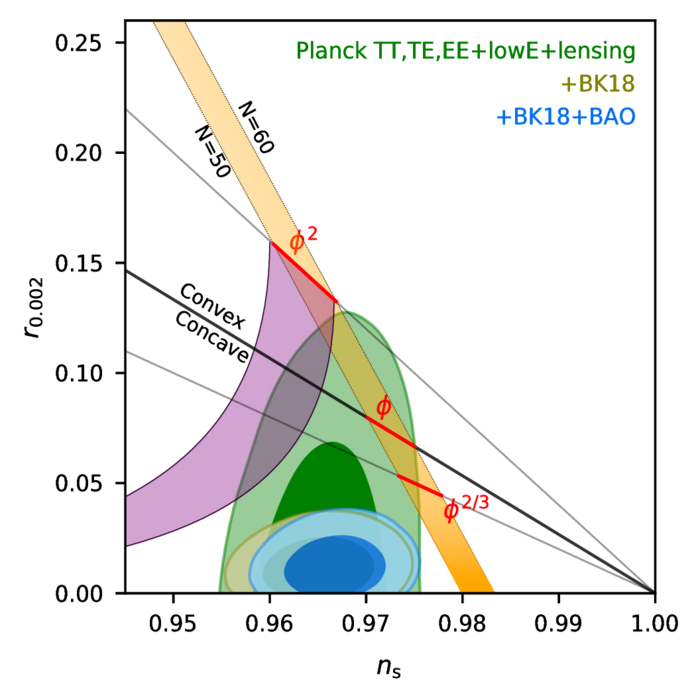
CMB B-mode Analysis
Generic inflationary models predict the existence of a background of primordial gravitational waves which would imprint a distinctive “B-mode” polarization in the CMB. A major focus of my work is analyzing the CMB B-mode data from the BICEP/Keck telescopes to constrain inflation models. These telescopes observe a ≈ 600-square-degree sky patch at multiple frequencies for two key goals: 1) targeting the degree-scale inflationary B-modes at the recombination bump; and 2) separating the polarized foregrounds from Galactic thermal dust and synchrotron emission.
In particular, we use data from BICEP2, Keck Array and BICEP3 at 95/150/220 GHz up to the 2018 observing season to produce polarization maps, compute B-mode power spectra and perform a multi-component multi-spectral likelihood analysis. This “BK18” analysis delivers unprecedented discrimination power among inflation models. As shown in the accompanying figure, two previously popular classes of inflation models (with a cosine-law and a monomial power-law potential) are now strongly disfavored by the data.
Telescope Mount
The BICEP/Keck collaboration is building BICEP Array (BA) to replace the Keck Array telescope and achieve tighter constraints on inflation models. BA will consist of four BICEP3-style receivers, significantly increasing detector count and extending frequency coverage to 30/40/95/150/220/270 GHz. The broader coverage enables improved separation of polarized foregrounds which dominate at opposite ends of the microwave spectrum.
A new telescope mount has been designed to support the full weight of the upgraded receivers and to enable precise scanning motion. We have worked on its mechanical assembly, electrical integration and structural testing. The accompanying video shows the partially assembled BA mount undergoing scan tests in a high bay, with a cold BA receiver installed. The system was later disassembled and shipped to the South Pole.

Telescope Deployment
An essential part of my work involves installing these telescopes at their remote observation site. During the austral summer of 2019, we deployed the BA1 30/40 GHz receiver and the newly built BA mount to the Amundsen-Scott South Pole Station, taking advantage of the site's exceptionally stable and transparent atmosphere for microwave observations. The deployment campaign included dismantling the Keck Array mount, installing the BA mount, assembling the BA1 receiver, and integrating the full system.
The attached photo shows the fully enclosed BA mount with BA1 receiver alongside three adapted Keck receivers at the end of the season. The first-light BA1 maps, generated from just 12 hours of data, reveals faint but characteristic CMB temperature anisotropies in the BICEP/Keck sky patch, demonstrating that the BA system was fully functional. With three years of data coadded in 2023, the resulting BA1 Q/U maps show the first robust detection of cosmological polarization at 40 GHz from the same sky patch. More details about the deployment campaign can be found on the BICEP Array construction blog.